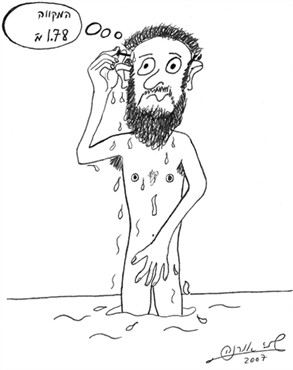
The amount of water in a ritual bath must be at least 40 se’ah (between 300 and 750 liters of water, depending on which rabbi one asks). If a person enters a ritual bath with an exact amount of water — 40 se’ah, no more and no less — and exits, the drops of water which cling to his skin will reduce the amount of water below the required 40 se’ah. Therefore, if another person immerses in the ritual bath, he will not be purified, for the ritual bath would not contain the amount of water required by Halacha. But if the first person has not yet completely left the water, if his feet are still in the bath but the rest of his body is out of the bath waters, one of the sages argues that we are to consider the water on his body as descending and rejoining the water in the bath, making the total amount of water in the bath still the 40 se’ah required for purification. (The drops of water on the man’s body are seen as still being connected to the water in the ritual bath). The scholars asked: According to this method, which sees the drops of water on the body of a person who has immerses as still connected to the waters in the ritual bath, are the waters which are in the bath also considered as ascending up to the head of the first person who immersed, making it as though his entire head is still in the bath? If this is so, could one use his head, which is actually outside the bath, to immerse needles which required purification, and have the needles be considered as immersed in the full 40 se’ah of ritual bath water? R’ Yochanan answers his students in the positive; one may use this method of immersing needles on a person’s head (though this conclusion is not entirely self-evident).
(Babylonian Talmud, Tractate Chagiga 19a)
